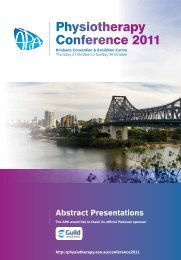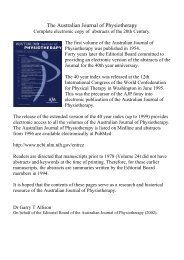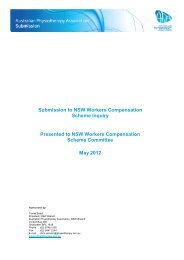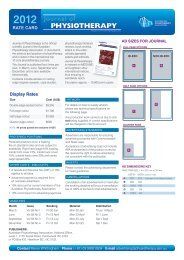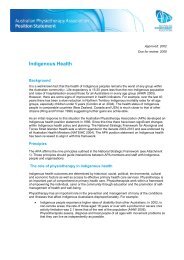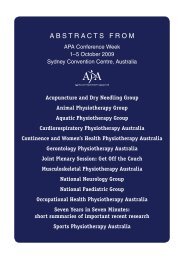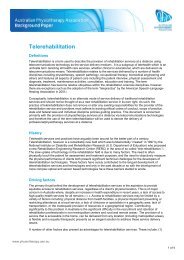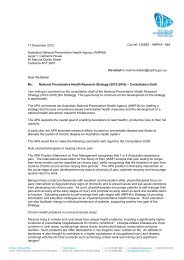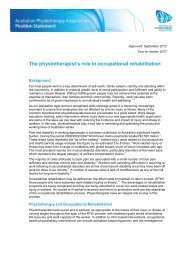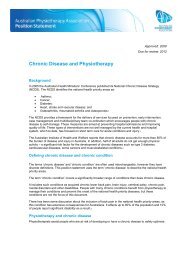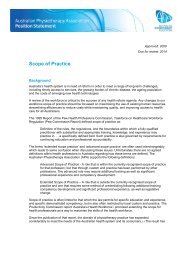The Australian Journal of Physiotherapy
The Australian Journal of Physiotherapy
The Australian Journal of Physiotherapy
You also want an ePaper? Increase the reach of your titles
YUMPU automatically turns print PDFs into web optimized ePapers that Google loves.
Bobath K and Bobath B (1956): Control <strong>of</strong> motor function in the treatment <strong>of</strong> cerebral palsy.<br />
<strong>Australian</strong> <strong>Journal</strong> <strong>of</strong> <strong>Physiotherapy</strong> 2: 75-85.<br />
This article discusses a neurophysiological treatment approach for cerebral palsy, arguing that the<br />
traditional methods <strong>of</strong> treatment formulated with an orthopaedic orientation are unsuitable for use in<br />
these patients with disordered motor function. <strong>The</strong> abnormal patterns <strong>of</strong> movement observed in<br />
patients with cerebral palsy are related to the release <strong>of</strong> reflex activity, and treatment techniques to<br />
overcome these influences and promote skilled movement are presented. <strong>The</strong> treatment approach<br />
centres around the inhibition <strong>of</strong> abnormal reflex activity and the facilitation <strong>of</strong> normal automatic<br />
movement patterns, and its theoretical background is proposed.<br />
Keywords: Cerebral Palsy; Movement Dysfunction; Physical <strong>The</strong>rapy<br />
West DR (1956): Movement education. <strong>Australian</strong> <strong>Journal</strong> <strong>of</strong> <strong>Physiotherapy</strong> 2: 85-89.<br />
<strong>The</strong> author describes her experiences in the teaching <strong>of</strong> physical education and the associated study<br />
<strong>of</strong> children's natural movements as forming the basis from which physical education teachers work.<br />
Qualities <strong>of</strong> movement are considered in terms <strong>of</strong> movement <strong>of</strong> the human structure. <strong>The</strong> much<br />
criticised lack <strong>of</strong> progression <strong>of</strong> this method <strong>of</strong> movement education is dismissed by the author as<br />
the child's growth is considered to be the yardstick <strong>of</strong> progression.<br />
Keywords: Child; Motor Skills; Movement; Physical Education and Training<br />
Abbie AA (1956): Nothing on the brain. <strong>Australian</strong> <strong>Journal</strong> <strong>of</strong> <strong>Physiotherapy</strong> 2: 90-94.<br />
A brief history <strong>of</strong> the evolution <strong>of</strong> man precedes an address <strong>of</strong> the functional aspects and<br />
comparative differences associated with the evolution and structure <strong>of</strong> the human brain. <strong>The</strong><br />
significance <strong>of</strong> the forebrain as the location for the seat <strong>of</strong> motor control and value <strong>of</strong> inhibitory<br />
mechanisms within this functioning are outlined. Emphasis is placed on the concept <strong>of</strong> 'nothing' as<br />
an active cerebral activity, a concept reinforced through evidence <strong>of</strong> areas <strong>of</strong> the brain set aside to<br />
ensure adequate inhibition.<br />
Keywords: Neural Inhibition; Neuroanatomy; Neurophysiology<br />
Dibden WA (1956): A two-year-old goes to hospital. <strong>Australian</strong> <strong>Journal</strong> <strong>of</strong> <strong>Physiotherapy</strong> 2:<br />
94-99.<br />
<strong>The</strong> issue <strong>of</strong> maternal deprivation is introduced with two brief case studies establishing the<br />
detrimental effect <strong>of</strong> prolonged separation <strong>of</strong> a child from it's mother. A film taken to document<br />
objective information on the behaviour <strong>of</strong> a child upon separation <strong>of</strong> it's mother is presented, and a<br />
synopsis given. Analysis <strong>of</strong> the film follows, highlighting the child's reactions both within and<br />
following the situation <strong>of</strong> separation from the mother.<br />
Keywords: Child Behavior; Child, Hospitalized; Maternal Deprivation<br />
Simpson D (1956): Residual disability after excision <strong>of</strong> brain tumours. <strong>Australian</strong> <strong>Journal</strong> <strong>of</strong><br />
<strong>Physiotherapy</strong> 2: 100-107.



